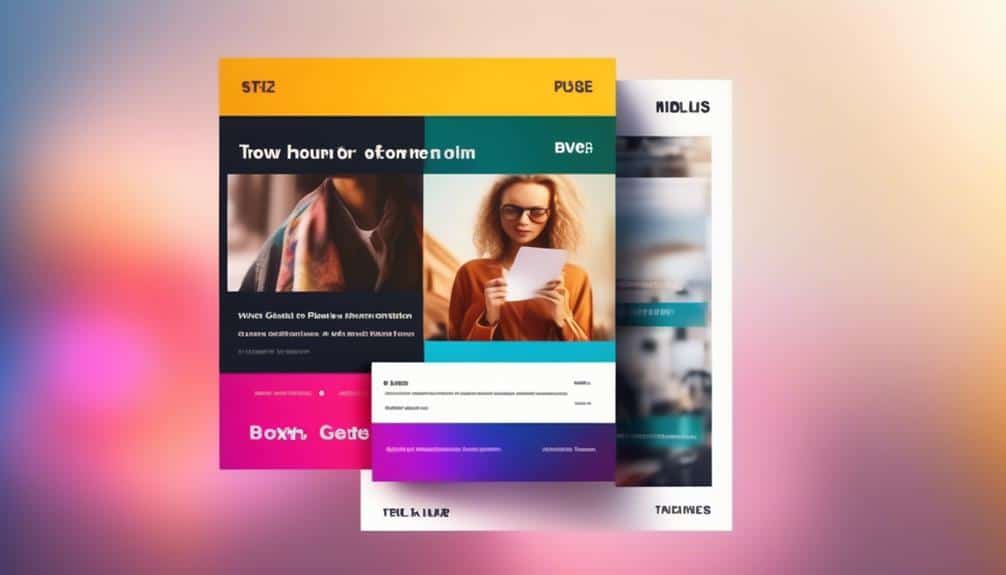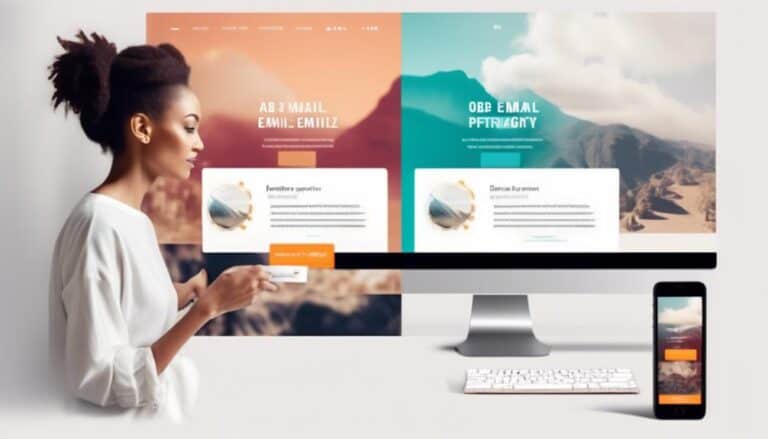Last Chance: Discover A/B Testing Tactics That Will Skyrocket Open Rates
Are your open rates not quite reaching the levels you desire? Well, here's some food for thought: did you know that by implementing effective A/B testing tactics, you can potentially increase your open rates by up to 30%?
That's right, a simple tweak in your email strategy could lead to significant improvements in engagement. But what exactly are these tactics, and how can you apply them to your own campaigns?
In this discussion, we'll explore the world of A/B testing and uncover the secrets to skyrocketing your open rates. Get ready to discover the key elements to test, craft compelling subject lines, optimize email design, and leverage personalization and segmentation strategies.
Curious to know more? Stay tuned.
Key Takeaways
- A/B testing is crucial for optimizing email open rates.
- Subject lines and email design elements should be tested to identify what drives higher open rates.
- Personalization techniques can increase the likelihood of email opens and make recipients feel valued.
- Timing and frequency of emails should be carefully analyzed and tested to find the optimal sending schedule for higher open rates.
Importance of A/B Testing for Open Rates

To maximize the effectiveness of your email marketing campaigns, it's crucial to understand the importance of A/B testing for open rates. A/B testing allows you to compare two different versions of an email to see which one performs better in terms of open rates. By conducting A/B tests, you can gain valuable insights into what resonates with your audience and optimize your email content accordingly.
One of the key metrics to consider when analyzing open rates is the subject line. A compelling subject line can significantly impact whether or not your emails get opened. Through A/B testing, you can test different subject lines to determine which ones generate higher open rates. You can experiment with different lengths, tones, and personalization techniques to find the optimal subject line that grabs your recipients' attention.
Another testing strategy to consider is the email design. By testing different layouts, colors, and call-to-action placements, you can identify the design elements that drive higher open rates. Additionally, testing the timing of your emails is essential. Experimenting with different send times can help you determine when your audience is most responsive and likely to open your emails.
Key Elements to Test in Your Email Campaigns
When it comes to optimizing your email campaigns, there are three key elements that you should focus on testing: subject lines, call-to-action variations, and layout and design.
The subject line is the first thing your recipients see, so testing different options can help determine which one resonates best with your audience.
Additionally, experimenting with different call-to-action variations can help improve click-through rates.
Lastly, testing different layouts and designs can help you identify what visually appeals to your subscribers, leading to higher engagement and conversion rates.
Subject Line Tests
Subject line tests are a crucial component of any email campaign, allowing you to optimize open rates and capture the attention of your audience.
To enhance the effectiveness of your subject lines, consider the following A/B testing strategies:
- Personalization: Test the impact of including the recipient's name or other personalized elements in the subject line. This can create a sense of relevance and increase open rates.
- Length: Experiment with different subject line lengths to determine the optimal character count. Shorter subject lines may be more concise and attention-grabbing, while longer ones may provide more context.
- Emotional appeal: Test subject lines that evoke different emotions, such as curiosity, urgency, or excitement. Emotional triggers can influence recipients to open your emails.
Call-to-Action Variations
By testing variations in your call-to-action elements, you can gather valuable data to optimize the performance of your email campaigns. The call-to-action (CTA) is a crucial component that prompts your audience to take action, such as making a purchase or signing up for a newsletter.
To improve conversion optimization and click-through rates, it's essential to experiment with different CTAs. You can test variations in wording, design, placement, and color to see which ones resonate best with your audience. For example, you could try using action verbs, changing the font size, or using contrasting colors that draw attention.
Layout and Design Experiments
To optimize your email campaigns, conduct layout and design experiments to test key elements and gather data-driven insights. By making layout and design improvements, you can enhance the user experience and increase the effectiveness of your emails.
Here are three items to consider testing:
- Header and footer design: Experiment with different styles, colors, and fonts to see which combination resonates best with your audience. A well-designed header and footer can make your emails more visually appealing and professional.
- Call-to-action placement: Test the placement of your call-to-action button within the email. Try placing it at the top, bottom, or in the middle to determine which position generates the highest click-through rates.
- Image usage: Evaluate the impact of using images in your emails. Test different sizes, positions, and types of images to see if they enhance or distract from the message you're trying to convey.
Crafting Compelling Subject Lines for Higher Open Rates
Crafting subject lines that captivate your audience is essential for achieving higher open rates in A/B testing. The subject line is the first thing your subscribers see in their inbox, and it determines whether they open your email or not. To optimize your subject lines for maximum engagement, you need to understand what resonates with your audience and evokes the desired emotions.
One effective way to craft compelling subject lines is by using a table that incorporates emotional triggers. Here's an example:
| Emotion | Subject Line Example | Open Rate Increase |
|---|---|---|
| Curiosity | "You won't believe this…" | 30% |
| Urgency | "Limited Time Offer: 24 hours left" | 25% |
| Excitement | "Get ready for something amazing!" | 20% |
| Fear | "Don't miss out on this opportunity" | 15% |
| Trust | "Exclusive invitation for our loyal customers" | 10% |
Optimizing Email Design for Maximum Impact

Optimizing email design can have a significant impact on the effectiveness of your campaigns, by structuring the layout and visual elements in a way that enhances engagement and drives higher click-through rates. To ensure maximum impact, consider implementing the following strategies:
- Email Personalization: Tailoring your emails to individual recipients can greatly improve their engagement. By using customer data and segmentation, you can personalize the content, subject lines, and even the design elements to resonate with each recipient on a more personal level. This personal touch can significantly increase open rates and click-through rates.
- Email Segmentation: Segmenting your email list based on specific criteria such as demographics, purchase history, or engagement level allows you to send targeted and relevant content to different groups of recipients. This approach ensures that each segment receives emails that are specifically tailored to their interests and needs, resulting in higher engagement and conversion rates.
- Eye-catching Visuals: Incorporating visually appealing elements into your email design can capture the attention of your recipients and encourage them to take action. Use high-quality images, vibrant colors, and clear call-to-action buttons to create an aesthetically pleasing and engaging email. Additionally, optimize your email for mobile devices to ensure a seamless experience for recipients who access their emails on smartphones or tablets.
Personalization and Segmentation Strategies to Increase Opens
For increased open rates, implementing personalization and segmentation strategies is crucial.
Personalization techniques allow you to tailor your emails to individual recipients, making them feel more valued and increasing the likelihood of them opening your emails. By using data-driven insights such as past purchase history, browsing behavior, or demographic information, you can create targeted and relevant content that resonates with your audience.
Segmentation strategies further enhance your open rates by dividing your email list into smaller, more specific groups based on common characteristics or interests. This allows you to send highly targeted emails that cater to the unique needs and preferences of each segment. By analyzing data on engagement levels, click-through rates, and conversion rates, you can identify which segments are the most responsive and adjust your strategies accordingly.
Additionally, using dynamic content in your emails allows you to personalize the email body or subject line based on specific data points, further increasing the chances of your emails being opened.
Testing Different Call-to-Actions in Your Email Content

By conducting A/B tests on different call-to-actions in your email content, you can gain valuable insights into which prompts are most effective at driving open rates and engaging your audience. Testing subject lines and measuring click through rates are two key strategies that can help you optimize your email marketing efforts.
Here are three reasons why testing different call-to-actions in your email content is essential:
- Maximize Open Rates: A compelling call-to-action can entice recipients to open your emails. By testing different CTAs, you can identify the wording, tone, and placement that resonate best with your audience, increasing the likelihood of them opening your emails.
- Improve Click Through Rates: The call-to-action in your email content plays a crucial role in driving recipients to take the desired action. Through A/B testing, you can identify which CTAs generate higher click through rates, allowing you to optimize your content and drive more conversions.
- Enhance Engagement: Engaging your audience is vital for building trust and fostering long-term relationships. By testing different call-to-actions, you can determine which prompts generate the most engagement, such as social media shares, comments, or replies, helping you tailor your content to better serve your audience's needs.
Leveraging Social Proof to Boost Open Rates
To further enhance the effectiveness of your email content, explore the power of leveraging social proof to boost open rates. Social proof tactics can be highly effective in increasing engagement with your email campaigns. By incorporating elements that show your subscribers that others have engaged with and found value in your content, you can build trust and credibility, leading to higher open rates.
One effective way to leverage social proof is by including testimonials from satisfied customers or clients in your emails. These testimonials can highlight the positive experiences others have had with your products or services, providing reassurance and encouraging your subscribers to open and engage with your emails.
Another tactic is to showcase any awards, certifications, or recognition your business has received. This can help establish your brand as a trusted authority in your industry, making your emails more enticing to open.
Additionally, including social media share counts or subscriber counts can also serve as social proof. By displaying the number of people who've already engaged with your content, you create a sense of FOMO (fear of missing out), motivating your subscribers to open your emails to stay in the loop.
Incorporating these social proof tactics into your email content can significantly increase engagement and open rates. Experiment with different approaches and measure the impact on your email performance to identify the most effective strategies for your audience.
Timing and Frequency: Finding the Sweet Spot for Opens

When it comes to email marketing, finding the right balance between timing and frequency is crucial for optimizing open rates.
By analyzing data and conducting A/B tests, you can determine the optimal time of day and day of the week to send your emails.
Additionally, it's important to strike a balance between sending too many emails, which can lead to subscriber fatigue, and not sending enough, which can cause your emails to be forgotten or ignored.
Optimal Email Timing
What is the best timing and frequency for emails to maximize open rates? When it comes to email engagement and open rate optimization, finding the optimal email timing is crucial. Here are three key factors to consider:
- Time of Day: Experiment with sending emails at different times of the day to determine when your audience is most likely to open them. Consider factors such as time zones and work schedules to ensure your emails are received at a convenient time.
- Day of the Week: Test different days of the week to identify the ones with higher open rates. Keep in mind that weekdays tend to have higher engagement compared to weekends, as people are more focused on work during weekdays.
- Consistency: Maintaining a consistent email schedule helps build anticipation and trust with your audience. Regularly sending emails at the same time and day can increase open rates over time.
Frequency and Open Rates
Considering the impact of email timing on open rates, it's now essential to explore the relationship between email frequency and open rates to find the optimal balance for maximizing engagement.
Conducting a frequency analysis is crucial for open rate optimization. Sending too many emails can lead to subscriber fatigue, resulting in decreased open rates. On the other hand, sending too few emails may cause your audience to forget about your brand, resulting in missed opportunities for engagement.
To find the sweet spot, analyze your open rates at different frequencies. Look for patterns and trends in your data to determine the ideal frequency that generates the highest open rates.
Finding the Right Balance
To maximize open rates, it's crucial to strike the right balance between timing and frequency of your emails, ensuring they're delivered at the optimal moment for your audience to engage. Finding the right approach requires careful analysis and experimentation.
Here are three key factors to consider when striking a balance:
- Audience Behavior: Study your audience's habits and preferences. Are they more likely to open emails in the morning or evening? Tailor your timing accordingly.
- Testing and Evaluation: Conduct A/B tests to determine the impact of different timings and frequencies. Analyze the data to identify patterns and trends that lead to higher open rates.
- Personalization: Customize your email delivery based on individual preferences. Use past interactions and behavior to send emails at times when your audience is most likely to engage.
Analyzing and Utilizing Data to Improve Open Rates

By analyzing data and utilizing insights, you can effectively improve open rates for your email campaigns. One way to do this is by analyzing data patterns to identify trends and patterns in your audience's behavior. Look at metrics such as open rates, click-through rates, and conversion rates to understand what's working and what isn't. Are certain subject lines or send times resulting in higher open rates? Are there specific types of content that resonate more with your audience?
By identifying these patterns, you can make data-driven decisions to optimize future campaigns.
Another way to improve open rates is by targeting specific demographics within your audience. Segment your email list based on factors such as age, location, interests, and past behavior. By tailoring your messaging to each segment, you can deliver more personalized and relevant content that's more likely to be opened and engaged with.
Use the insights gained from analyzing your data patterns to inform your targeting strategy. For example, if you notice that a certain age group has a higher open rate for emails with a specific type of content, you can create more targeted campaigns for that segment.
Implementing A/B Testing Best Practices for Long-term Success
To achieve long-term success with improving open rates, it's crucial to implement A/B testing best practices that leverage data-driven insights and analytical approaches. By following these best practices, you can optimize your email campaigns and ensure that your messages are reaching your audience effectively.
Here are three key strategies to consider:
- Conduct A/B testing case studies: One of the most effective ways to improve open rates is by conducting A/B testing case studies. This involves creating two versions of your email campaign and testing them with different segments of your audience. By comparing the performance of each version, you can identify the elements that resonate best with your subscribers and make data-driven decisions to optimize future campaigns.
- Segment your audience: To truly understand the impact of your A/B tests, it's essential to segment your audience. By dividing your subscribers into different groups based on demographics, preferences, or past behavior, you can tailor your email content to their specific needs and interests. This targeted approach can significantly improve open rates and engagement.
- Measure open rates accurately: Accurate measurement is crucial for evaluating the success of your A/B testing efforts. Use reliable email marketing tools to track open rates and analyze the data. Pay attention to metrics such as unique opens, open rates over time, and opens by device. These insights will allow you to identify trends, make informed decisions, and continuously improve your open rates.
Frequently Asked Questions
How Does A/B Testing Affect Click-Through Rates in Email Campaigns?
A/B testing can greatly impact click-through rates in email campaigns. By analyzing the results, you can identify which version of your campaign resonates better with your audience, leading to improved click-through rates and ultimately higher engagement.
What Are Some Common Mistakes to Avoid When Conducting A/B Tests for Open Rates?
When conducting A/B tests for open rates, common mistakes to avoid include not having a clear hypothesis, testing too many variables at once, and not collecting enough data. Follow best practices to ensure accurate and actionable results.
How Can I Measure the Impact of Personalization on Email Open Rates?
To measure the impact of personalization on email open rates, start by analyzing long term improvements. Look at data-driven insights to see how personalized content affects engagement. Serve your audience by understanding what resonates with them.
Are There Any Specific Design Elements That Consistently Lead to Higher Open Rates?
Using A/B testing, you can identify specific design elements that consistently lead to higher open rates. Experiment with different layouts, colors, fonts, and call-to-action buttons to optimize your email's impact and engagement.
How Can I Effectively Analyze and Interpret the Data Obtained From A/B Testing to Improve Open Rates in the Long Term?
To effectively analyze and interpret A/B testing data for long-term open rate improvement, focus on improving segmentation and optimizing subject lines. By diving deep into the data and making data-driven decisions, you can serve your audience better.
Conclusion
In conclusion, A/B testing is a crucial strategy for improving open rates in email campaigns.
By testing key elements such as subject lines, email design, personalization, and timing, you can optimize your campaigns for maximum impact.
Leveraging social proof and analyzing data can also help boost open rates.
By implementing A/B testing best practices, you can achieve long-term success and continuously improve your email open rates.








